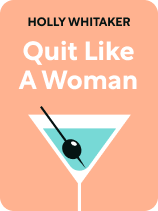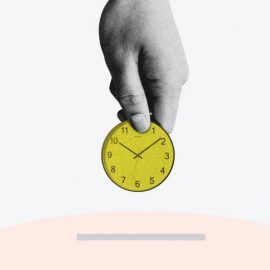

This article is an excerpt from the Shortform book guide to "Quit Like a Woman" by Holly Whitaker. Shortform has the world's best summaries and analyses of books you should be reading.
Like this article? Sign up for a free trial here.
What is the solution to alcoholism? Why are the five facets of recovery?
In Quit Like a Woman, Holly Whitaker breaks her recovery approach into five facets. She stresses that this type of recovery isn’t linear and goal-oriented, but rather a journey where you discover yourself as you get sober.
Read below for more about Whitaker’s helpful solution to alcoholism.
Facet #1: Be Kind to Yourself
Whitaker argues that one of the most important facets of your recovery journey to find the solution to alcoholism is to learn to be kind to yourself to heal your inner wounds. Only when you’re gentle and forgiving with yourself, rather than severe and punitive, will you be able to stop suffering permanently. Let’s look at several aspects of practicing kindness toward yourself.
See Yourself as Inherently Good and Worthy
View yourself as innately good and worthy of happiness and fulfillment, insists Whitaker. When you see yourself as broken and unworthy, you’ll beat yourself up when you misstep, and this negativity will only turn you more to the substances you’re trying to avoid.
Understand that to recover and build a fulfilling life free from addiction, you don’t need to remove, suppress, or hide parts of yourself, writes Whitaker: You’re good just as you are. Instead, find the right tools, systems, and structures that allow you to thrive.
Understand Your Inner Wounds
Additionally, seek to understand what inner wounds you’ve used addictive substances to try to heal, advises Whitaker. Inner wounds can result from extreme events like assaults, exposure to warfare, childhood neglect, and so on. They can also come from the less acute negative events that occur on a daily basis, like being yelled at by your boss or broken up with. When you understand your inner hurt, you can treat yourself more kindly because you know why you engage in negative or self-destructive behaviors—you don’t think it’s simply an inherent weakness you must stamp out.
Be Willing and Committed, Nothing More
Whitaker asserts that you can further be kind to yourself by simply committing and being willing to recover. “Committing” implies you’re independently choosing to pursue sobriety and that if you accidentally veer from that path, you can get back on it with no further negative consequences. Similarly, being “willing” implies that you don’t have to know exactly how to recover but that you’re open to discovering. Both framings allow for slips (which are human and inevitable) and inexperience (which is also natural).
Trust That You Know What’s Best for You
Trust your instincts about how to best recover, stresses Whitaker. You know yourself and your needs better than anyone else, so give yourself permission to trust your gut, even when doing so goes against the norm. You should consider the expert advice of therapists and other guides, but always run their advice past your own internal judge before implementing it.
Let Yourself Feel Emotions Without Self-Judgment
Whitaker further recommends that you allow yourself to feel emotions, positive or negative, without suppressing them or judging yourself for having them. This lets you cope healthily with the emotion rather than having it consume you and ultimately drive you back to addictive behavior.
For instance, if you feel envious of your friend who’s just purchased a car while you struggle to get out of your gambling debt, allow yourself to feel that envy without self-judgment. This way, you can work through your envy and let it pass, rather than suppressing it and having it emerge in destructive ways, like through further gambling or vindictive actions toward your friend.
Facet #2: Form New, Good Habits to Replace Old, Bad Habits
The second facet of recovering is to create positive habits that make you think less about whether to engage in an addictive habit, writes Whitaker. When you automate healthy processes in your daily life that replace old, addictive processes, you reduce the amount of conscious thought you put into them and give yourself less opportunity to even consider engaging in the addictive behavior.
For instance, if you’re trying to overcome a fast food addiction and normally stop by McDonald’s to soothe yourself with food after work, you might form the new habit of stopping by a park on the way home and sitting in the sun. Once you’ve solidified this habit, you won’t have to work so hard to resist McDonald’s because your decision to go to the park will be almost automatic.
Good Habits Help You Combat Cravings
Setting up healthy habits also helps you manage your energy levels so you can cope with cravings when they inevitably arise, argues Whitaker. By creating routines through which you maintain steady energy over the course of the day, you never become so overwhelmed that you crave a depressant (like alcohol) to settle down or so depleted that you don’t have the energy to withstand cravings.
To do this, Whitaker recommends setting up a morning routine that involves meditating, reading a short, inspirational piece of writing, and drinking hot water with lemon—all with your phone off. Similarly, set up an evening routine that provides you with habitual enjoyment to replace the pleasure you’d normally get from an addictive substance: You might have a list of new shows to try or cozy up with a good book.
Facet #3: Set Up a Sustainable, Self-Protective Lifestyle
The next facet of Whitaker’s recovery strategy is to set up a long-term lifestyle that makes you happy, maintains your mental health, and protects you from people and things that could trigger addictive behaviors. There are five parts to this.
Part 1: Put Yourself First
Whitaker insists that you always put yourself first to ensure you’re giving yourself the support you need. Stop trying to constantly please others (for instance, by responding immediately to all messages or doing someone else’s work for them) because this depletes your energy and erodes your sense of self—two things you need to stay healthy.
Instead, set up boundaries that define what you are and are not willing to do for others, writes Whitaker. Sticking to those boundaries means you’ll likely need to start saying “no” a lot. You may feel guilty about this at first, but after a while, both you and those around you will adjust to your boundaries (and those that don’t will leave, to both your benefit).
Part 2: Assemble a Set of Tools for Coping With Low Moments
Create a set of 10 healthy coping strategies that help you when you’re feeling down, recommends Whitaker. These can be activities (like yoga and exercise), objects (like comfortable clothes and blankets), or foods (like teas or chocolates). Having these go-to coping strategies enables you to heal yourself without the use of addictive substances.
Part 3: Take Care of Your Health
To maintain a healthy lifestyle over the long term, follow the simple, conventional guidelines for healthy living, writes Whitaker: Eat well, sleep well, drink plenty of water, and exercise regularly.
Part 4: Fill Your Life With Other Forms of Fun
Find forms of fun to replace the old, self-destructive ways you had fun, recommends Whitaker. These can be “normal” activities, just without the addictive substance (eating out, going to museums, picnics), childish activities (visiting a theme park, bouncing on a trampoline, goofing around with friends), or spending quality time alone (with a good book, show, or craft).
Part 5: Engage Constructively With Cravings When They Arise
Whitaker asserts that cravings will arise but that you can cope with a craving by 1) accepting it, 2) ignoring the negative narratives you’ve woven around the craving (such as the belief that you can never resist cravings, that cravings mean you’re weak, and so on), 3) exploring the physical sensations of the craving—for instance a tightness in your chest, clenched fists, or other physical changes, and 4) waiting the craving out by not acting on it.
Facet #4: Deal Effectively With Other People
The fourth facet of your recovery journey is learning how to deal effectively with others, writes Whitaker. Navigating relationships as a newly sober person can be difficult because many of them will change now that you’re no longer drinking. Here are some ways Whitaker recommends dealing with new and old relationships.
View Every Relationship and Interaction as a Learning Opportunity
View everyone you encounter along your sobriety journey as a teacher helping you grow, recommends Whitaker. In this way, you can frame difficult people and situations not as obstacles to your happiness, but rather as enablers of your future happiness because they alert you to what you will and won’t tolerate.
Give Yourself Permission to Change
When you become sober, you’re allowed to change in other, broader ways, assures Whitaker. You don’t owe it to anyone to remain the same person or to continue participating in activities you no longer enjoy. This might mean you lose some of the friends with whom drinking was your main shared activity and other friends who simply can’t be part of your journey—that’s okay. You’ll make new friends, as we’ll discuss next.
Create a Strong Support Network
While Whitaker touts the virtues of spending time alone to get in tune with yourself, she also notes that it’s critical to establish a strong support network because all humans need community and close connections. This should consist of several types of supporters: advisors (mentors, teachers, therapists), other sober people, and intimate friends.
She stipulates that you don’t need a huge support network and indeed warns against feeling that your worth is measured by how many friends you have. However, you must resist the urge to fully isolate yourself during recovery because you believe you need time alone to get back in touch with yourself. While reconnecting with yourself is important, being alone all the time isn’t sustainable or healthy. Whitaker offers recommendations for how to find new friends in your sobriety: Seek out sober events, workshops, retreats, meetings, and personalities on social media. Additionally, make new friends whose interests and life goals align with yours (for instance, through volunteerism or activism). No matter what, you must take risks to get out there, and it will probably be hard. Be patient: You will eventually find a group of supporters.
Facet #5: Harness Recovery as a Social Justice Tool
Finally, as you progress through your recovery journey to achieve the solution to alcoholism, the new ways you see the world and the critical eye you bring to existing systems (the alcohol industry and our collective belief in the goodness of alcohol, for example) might attune you to broader injustices in the world. As you open your eyes to iniquity and oppression, consider using that knowledge to help catalyze change.

———End of Preview———
Like what you just read? Read the rest of the world's best book summary and analysis of Holly Whitaker's "Quit Like a Woman" at Shortform.
Here's what you'll find in our full Quit Like a Woman summary:
- Why society misunderstands what alcohol addiction is, what causes it, and how to treat it
- Why alcohol is always bad for you, even in moderation
- A feminine, holistic approach to recovery and sobriety






